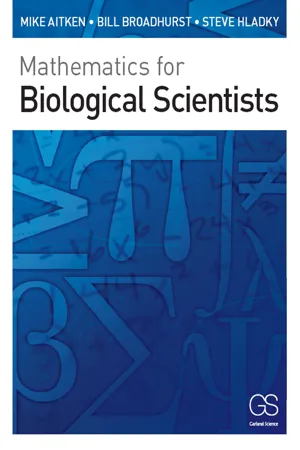Mathematics
The Power Rule
The Power Rule is a fundamental concept in calculus that allows for the differentiation of functions raised to a power. It states that the derivative of x raised to the power of n is n times x raised to the power of (n-1). This rule is essential for finding the derivatives of polynomial functions and is a key tool in calculus for solving problems involving rates of change.
Written by Perlego with AI-assistance
Related key terms
Related key terms
1 of 4
Related key terms
1 of 3
4 Key excerpts on "The Power Rule"
- eBook - ePub
- Mike Aitken, Bill Broadhurst, Stephen Hladky(Authors)
- 2009(Publication Date)
- Garland Science(Publisher)
x,n) is a function with two arguments; there is no reason why a function need be restricted to just one argument.The function, power (x,n), is defined by the procedure in Section 2.3 together with rules for the domain and range. The procedure alone is not enough because it does not satisfy the condition that it must produce one and only one answer. For instance there are two real values of y such that y = 41/2 , either +2 or −2, and there is no real value of y that satisfies y = (−1)1/2 . However, if we restrict x so that it must be greater than or equal to 0, written x ⩽ 0, and we insist that the answer is also positive, y ⩽ 0, then we do have a function that produces a unique answer to any accuracy we desire. The power function implemented in calculators and computers is defined for x and n as numbers. It sometimes makes sense to allow x to represent a physical quantity, but n will always be just a number.There are three main methods for displaying a rule for calculating the result of a function: state an expression or a procedure for calculation; list values in a table; or draw a graph. We have already looked at examples of expressions and procedures that define functions. Some of these are simple enough to be evaluated just using the basic operations of arithmetic. These include polynomial functions that are defined by rules like f(x) = x2 + 2x + 1. In the general case, a polynomial function involves only a sum of terms in integer powers of x. Rational functions are a more general class of functions that are ratios of two polynomials. With enough terms, you can make a graph of one of those look like almost anything. It is rare for a polynomial or rational function to be exactly what we want in a biological application. Nevertheless, they are very important as they are easy-to-use approximations to more awkward functions. We have also seen a more complicated procedure that defines a function: finding xn for x ⩽ 0 when n - eBook - ePub
- Gregory Hill, Mel Friedman(Authors)
- 2013(Publication Date)
- Research & Education Association(Publisher)
CHAPTER 4
Rules of Differentiation
CHAPTER 4
RULES OF DIFFERENTIATION
4.1INTRODUCTION
It would be an extremely tedious process to always determine derivatives by the use of limits. As a result, derivative rules for a wide variety of functions can be established by using limits, and those rules become the more efficient tools for finding derivatives. Since this text is not intended to be a first exposure to calculus, most of the derivative rules will be given without proof, although a few key derivatives will be established through limits.4.2DERIVATIVES OF POLYNOMIALS
Some derivatives can be determined just from the knowledge that a derivative represents the slope of the function. For instance, the derivative of a constant is zero, since the slope of the graph of y = c, where c is a constant, is 0.Derivative of a Constant
Using similar reasoning, the derivative of any linear function is the slope of that function.If c is any constant, and y = c, thenDerivative of a Linear Function
If m is any constant, and y = mx, thenThe derivative of a power of x is also relatively straightforward, but perhaps not intuitively understood. If m is any natural number, and f(x) = xm thenThe proof of this rule utilizes the definition of the derivative and the binomial expansion pattern from a prerequisite course.Although the binomial expansion from courses prior to calculus applies only to exponents that are natural numbers, we will extend the derivative rule (without proof) to any exponents that are elements of the real numbers.Derivative of a Power
If m is any real number, and f(x) = xm , thenThe derivative of any constant multiple of a power of x is established by factoring the constant out of the limit. Therefore, the coefficient simply multiplies by the power.Derivative of a Constant Times a Function
If c and m are constants and y = cxm , thenExtending derivatives of monomials to polynomials is also elementary. Since a polynomial is the sum of monomials, and derivatives are proven by limits, when each is defined, the limit of a sum equals the sum of the limits. - Stu Schwartz(Author)
- 2013(Publication Date)
- Research & Education Association(Publisher)
x. It makes no difference what variable is used to represent this change.Derivatives of Algebraic FunctionsOverview: Differential calculus requires you to be able to take derivatives quickly and efficiently. For algebraic functions, there are four rules that you must know backwards and forwards.The process of taking derivatives is called differentiation.EXAMPLE 7:If f (x) = (x2 + 6x + 10)(2x2 − 7x − 1), find f ′(−2).SOLUTION:Use the product rule as it is too time-consuming to expand the expression.f ′(x) = (x2 + 6x + 10)(4x − 7) + (2x2 − 7x − 1)(2x+6) (−2).If you were asked to find f ′(x) in a simplified form you would need to expand this expression. But you only want f ′(−2) so simply evaluate the expression at x = −2.f ′(−2) = (2)(−15) + (21)(2) = 12EXAMPLE 8:Given , find .SOLUTIONS:There are three ways to handle this problem:a) The quotient rule:b) Splitting it:To take the derivative of , you could either use the quotient rule or write it as 3x −1 . In any case, the final answer is . While not in the same form as the quotient rule method above, the two are equivalent by using a common denominator.c) Using the product rule:This answer is equivalent to the others by expressing with a common denominator. But it takes a few steps.TESTTIPWhich way do you handle derivatives involving quotients? The quotient rule is difficult for some students and many will do anything to avoid using it. But using the product rule ends up involving negative exponents, which are rarely in AP exam multiple-choice answers. If a problem can be split into individual fractions which have their derivatives easily taken, do so. But sometimes you have to live with the quotient rule. So learn it and remember that if your answer doesn’t match one of the given multiple-choice answers, a little algebraic cleanup might be necessary.- eBook - ePub
Financial Simulation Modeling in Excel
A Step-by-Step Guide
- Keith A. Allman, Josh Laurito, Michael Loh(Authors)
- 2011(Publication Date)
- Wiley(Publisher)
A.3 ):(A.3)Now imagine that equation A.1 had a second variable, y, associated with it (equation A.4 ):(A.4)With two variables, it would be necessary to measure the change of f (x,y ) relative to x while keeping y fixed, and vice versa. And indeed, this is how a partial derivative is defined. So what does all this mean? Let's take the partial derivative of equation A.4 with respect to x (equation A.5 ):(A.5)First off, notice that when doing partial derivatives, the notation changes from d to ∂. You may also notice that by using the Chain Rule we have added a new term, the partial of y with respect to x. Recall that when taking the partial derivative of a function, f, with respect to x, all other variables are remained fixed. Practically speaking this means they can be viewed as constants, much like “4” is a constant, and is reduced to zero. Equation A.5 can be simplified to equation A.6 .(A.6)To complete our example, we will now take the partial with respect to y (equation A.7 ).(A.7)Conceptually what we just determined is the slope along the x and y direction respectively.ORDINARY DIFFERENTIAL EQUATIONS (ODE)The next step to understanding partial differential equations (PDE) is to understand an ODE, or ordinary differential equation. But before we can even discuss that, let us first review “equations” in general and their “solutions.” Suppose we were given the following equation (equation A.8 ):(A.8)The solution(s) to equation A.8 is the value that x can take that satisfies the equality. In this example, there is only one solution, and that is x = 3. We employ a similar concept when dealing with ODEs. However, instead of trying to determine a set of values a variable can take to satisfy the equality, we are trying to find a function that, when its derivates are taken, satisfies the given differential equation. An ODE deals strictly with regular derivatives, and as we saw in the last section, this means they only operate on functions with one variable. In their simplest form, ODEs look something like equation A.9
Index pages curate the most relevant extracts from our library of academic textbooks. They’ve been created using an in-house natural language model (NLM), each adding context and meaning to key research topics.
Explore more topic indexes
Explore more topic indexes
1 of 6
Explore more topic indexes
1 of 4



